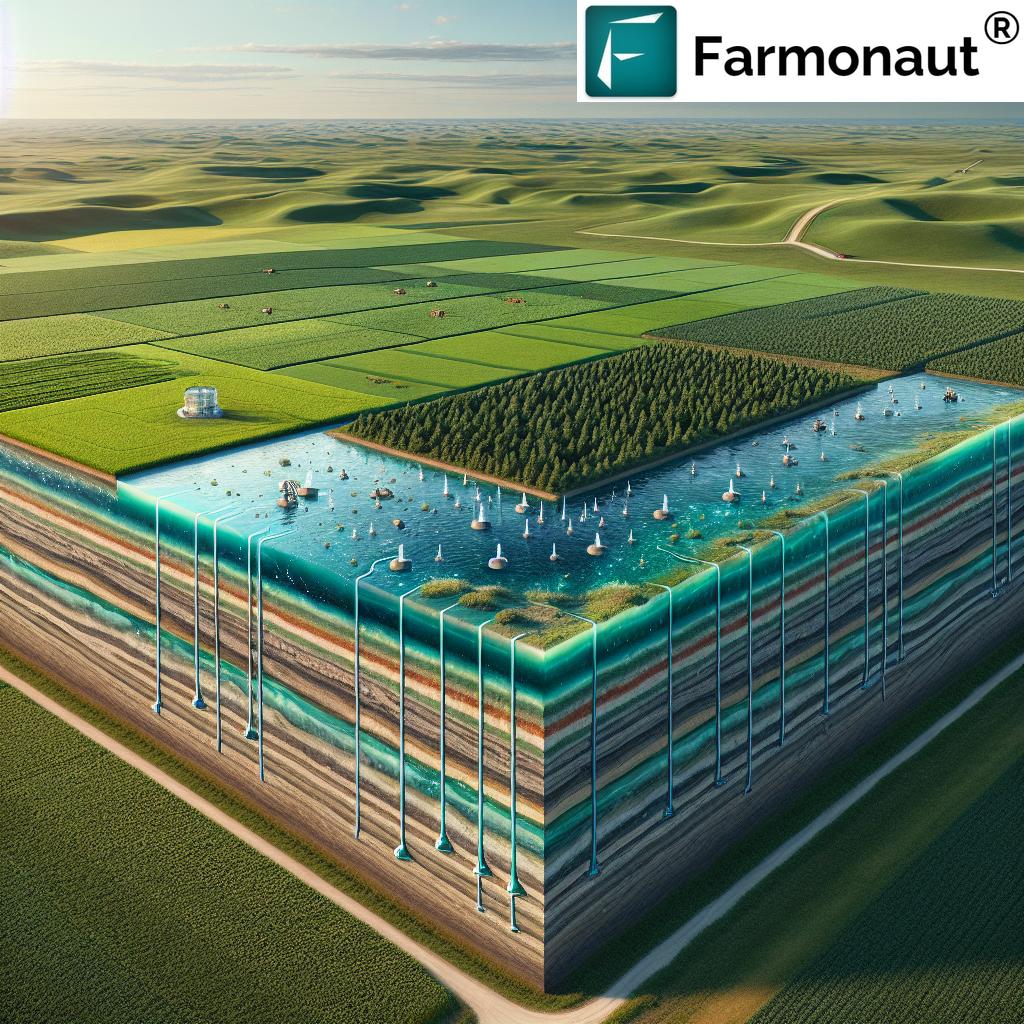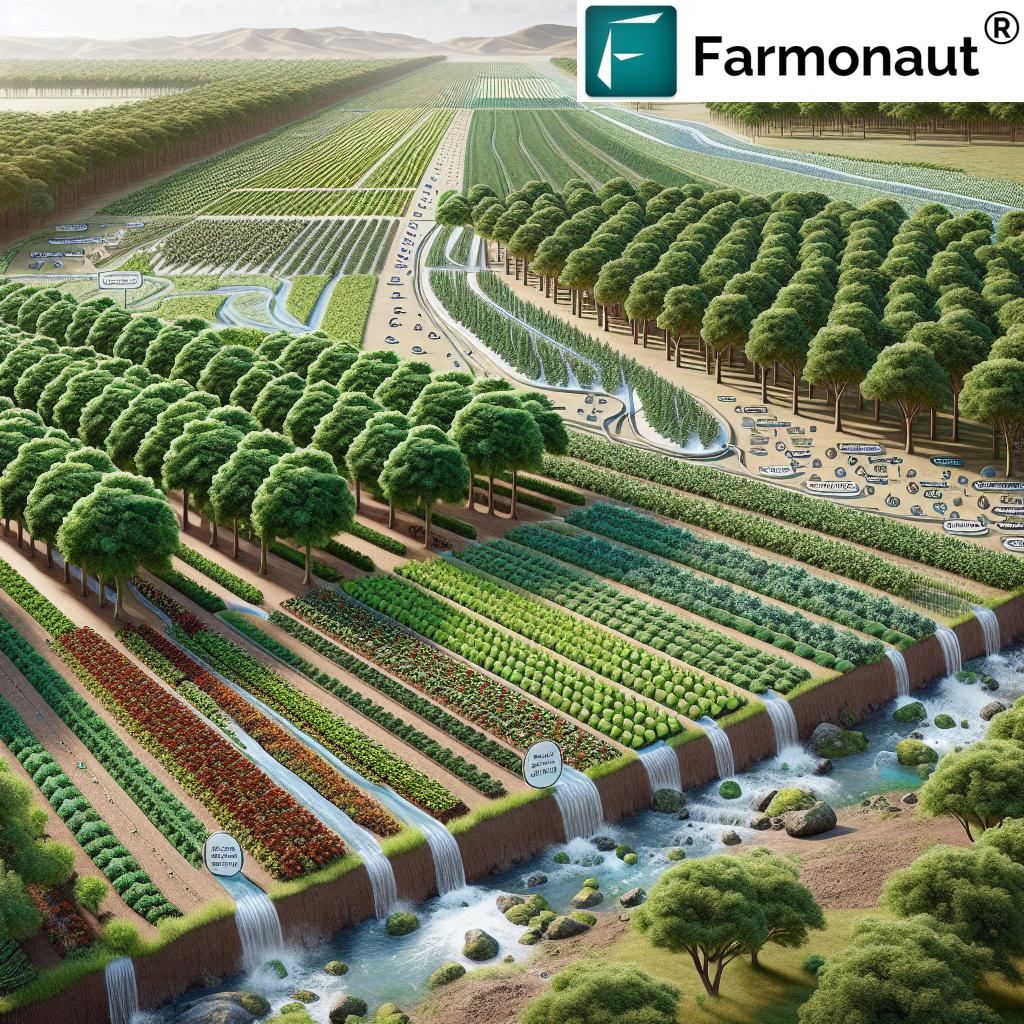An Aquifer Miracle: 7 Secrets to Save Ogallala Now!
“The Ogallala Aquifer supplies water to 27% of U.S. irrigated land, supporting $20 billion in annual agricultural production.”
Introduction: Why Aquifers Matter
Aquifers are vast, underground layers of water-bearing rock and sediment that store some of the world’s most crucial freshwater resources. They serve as a reliable source of water for a multitude of human activities, especially in agriculture and farming. To achieve sustainable resource management and provide environmental conservation in regions like the US Plains, we must fully understand the impact of aquifer use—particularly in cropping, forestry, and irrigation-based industries.
The Ogallala Aquifer—one of the largest and most heavily tapped in the world—underlies the Great Plains of the United States. It has long sustained our ability to grow crops, irrigate fields, and feed much of the nation and the world. However, over-exploitation threatens not only this underground source but also the long-term viability of the agricultural sectors it supports.
In this comprehensive guide, we’ll reveal the 7 secrets to save the Ogallala Aquifer and ensure a resilient, sustainable future for our forests, farms, and the communities that depend on these precious water levels.
The Ogallala Aquifer: Our Underground Lifeline at Risk
The Ogallala Aquifer stretches across eight states—South Dakota, Nebraska, Wyoming, Colorado, Kansas, Oklahoma, New Mexico, and Texas—and constitutes one of the world’s largest bodies of groundwater. It supplies irrigation water to roughly 27% of all farmland in the United States and supports nearly $20 billion in annual crop production.
Nevertheless, intensified irrigation, over-reliance on groundwater, and unsustainable practices have resulted in dramatic declines in aquifer levels. In some regions of the southern Plains, aquifer depletion has reduced water availability for farming and threatens the food security of future generations.
Let’s dive into the first of our 7 transformative secrets—a roadmap to sustainable groundwater management that ensures aquifers and agriculture thrive side by side.
Secret 1: Monitor and Manage Groundwater Levels Proactively
The foundation of sustainable groundwater management is real-time monitoring coupled with proactive decision-making. By consistently tracking aquifer levels, farmers and foresters can adjust irrigation and water extraction practices—avoiding excessive use that leads to rapid depletion.
- Satellite-Based Monitoring: Solutions like Farmonaut’s satellite crop health monitoring empower us to monitor soil moisture, vegetation health, and even well recharge rates with multispectral precision.
- AI-Driven Insights: Platforms that integrate artificial intelligence (such as Farmonaut’s Jeevn AI Advisory System) analyze changing groundwater trends and weather forecasts, helping us plan irrigation and fertilizer application for optimal water conservation.
- Widespread Data Accessibility: Accessible via Android, iOS, or web apps, these technologies democratize efficient resource management across farms of any size.
Key Benefits of Groundwater Monitoring in Aquifers and Agriculture
- Prevents over-withdrawal and depletion of underground reserves
- Supports efficient irrigation scheduling to maintain soil moisture
- Enables timely interventions during drought or periods of scarcity
- Promotes sustainability and resilience of agricultural & forestry sectors
Unlock precision farming for your land with real-time crop, soil, and water monitoring.
Get started with Farmonaut’s multi-platform system here.
What Makes Satellite Monitoring Essential?
Unlike manual or spot-based methods, satellite data covers vast regions in a single snapshot, helping us identify subtle changes in groundwater storage and crop status. This is crucial for Ogallala Aquifer irrigation zones and environmental conservation efforts worldwide.
Quick Links to Farmonaut Technology
- API Integration for Advanced Monitoring: Developers and enterprise organizations can integrate satellite–weather data using the Farmonaut Satellite-Weather API or dig deeper with the API Developer Docs.
- Fleet and Resource Management: Reduce operational costs for agri-businesses and manage water-distribution vehicles efficiently via Fleet Management Solutions.
- Large Scale Farm Monitoring: Plantation managers and agribusinesses can check the Agro-Admin Application for multi-field, multi-user precision management.
Secret 2: Adopt Efficient Irrigation Techniques
An overwhelming share of Ogallala Aquifer extraction is devoted to irrigating crops on the Great Plains. To secure the aquifer’s future, we must rapidly transition from traditional, water-intensive systems to highly efficient irrigation methods.
Leading Practices to Reduce Aquifer Depletion
- Drip Irrigation: Delivers moisture directly to plant roots, reducing runoff and evaporation. This technique can save up to 50% of the water used by surface methods.
- Pivot and Sprinkler Systems: Automated control optimizes usage, ensuring we use only the amounts required for crop growth and health.
- Smart Irrigation Scheduling: Coupling satellite soil moisture data with local weather predictions, we fine-tune when, where, and how much to irrigate—fostering sustainable groundwater management.
- Alternative Wetting and Drying (AWD): Particularly in rice, this technique—increasingly popular in the southern United States—intermittently dries fields rather than keeping them flooded, seriously curbing aquifer depletion.
By reducing water use and boosting resource efficiency, these strategies allow us to maintain crop yields while minimizing impact on aquifer levels.
“Sustainable forestry can reduce aquifer depletion by up to 30% through improved groundwater recharge and reduced surface runoff.”
Secret 3: Leverage Smart Technologies for Precision Agriculture
Harnessing cutting-edge tools is the lynchpin of groundwater conservation practices. Platforms like Farmonaut deliver an arsenal of smart features for aquifer health, yield optimization, and irrigation efficiency.
- Satellite Crop Health Surveillance: Pinpoints areas of moisture stress, allowing us to allocate limited resources for maximum impact.
- AI Advisory: Jeevn AI empowers farmers with customized strategies on fertilization, irrigation, and disease management based on real-time, spatially accurate data.
- Resource Management: Track the fleet and machinery efficiently, plan well recharge schedules, and calculate carbon footprints to ensure sustainability throughout our operations. See more at Farmonaut Carbon Footprinting.
- Blockchain-Based Traceability: Build trust and transparency in food supply chains with product traceability—helping ensure that crops grown with sustainable water management are documented and recognized.
Let’s dissolve guesswork from farm management to make every drop count, ensuring our practices lead to environmental conservation and economically viable yields.
Secret 4: Integrate Forestry and Water Resource Management
While forestry and agriculture are often managed separately, their integration is pivotal for aquifer conservation. Healthy forests support the hydrological cycle and dramatically influence groundwater recharge in forestry regions.
Forestry and Water Resources: Allies for Sustainability
- Canopy Interception: Tree canopies intercept rainfall, reducing surface runoff and allowing more water to infiltrate beneath the soil, directly replenishing aquifers.
- Forest Filters: Forests trap sediments and pollutants, maintaining the purity of groundwater supplies. Buffer zones along riverbanks can intercept and filter out nutrient-rich runoff, helping to sustain water quality.
- Sustainable Forestry Practices: Careful selection of tree species (avoiding water-thirsty trees like eucalyptus in sensitive areas), balanced planting approaches, and protection of native forests all play a role in maintaining aquifer levels.
- Agroforestry: Blending tree cover with crops or pastures increases biodiversity and creates a steady system for recharge while supporting agricultural yields.
Integrating forestry and water resources policies yields a double dividend: water security and stronger ecological health for all.
For tailored, science-based forestry recommendations, access Farmonaut’s Crop Plantation & Forest Advisory.
Secret 5: Replenish Aquifers through Groundwater Recharge Practices
Slowing the pace of aquifer depletion requires that we not only reduce extraction but actively pursue recharge techniques. By enhancing the infiltration of surface water into underground rock and sediment layers, we can extend the usable life of the Ogallala Aquifer.
- Recharge Basins and Ponds: Creating shallow, vegetated basins or ponds enables runoff water to slowly percolate into depleted aquifers, mimicking natural cycle dynamics.
- Managed Aquifer Recharge (MAR): This involves purposefully spreading water across the landscape (using canals or flooding) to boost recharge rates in strategic zones.
- Forest Restoration: Intact forests naturally recharge aquifers by promoting water infiltration and reducing siltation of stream beds.
Impact of Irrigation on Aquifers
Excess and poorly-timed irrigation triggers runoff and even soil erosion, lowering the aquifer’s ability to recharge. Tailoring practices to retain moisture on-site is key for long-term aquifer sustainability.
We must look to both traditional techniques (such as contour bunding and terracing) and modern solutions (precision water management) to support a resilient, drought-proof future.
Comparative Data Table: Impact of Sustainable Practices on Ogallala Aquifer Levels
| Practice/Intervention | Estimated Water Savings (%) | Impact on Aquifer Recharge | Potential Crop Yield Change (%) | Additional Environmental Benefits |
|---|---|---|---|---|
| Drip Irrigation | 40–60% | Medium | +10 to +30% | Reduces runoff & soil erosion, saves energy |
| Crop Rotation | 10–25% | Medium | +5 to +15% | Improved soil health, pest management |
| Agroforestry | 25–35% | High | +5 to +20% | Biodiversity gains, microclimate stability |
| Traditional Flood Irrigation | 0–10% | Low | 0 to -15% | Inefficient, increases runoff & pollution |
| Managed Recharge | N/A (Direct Recharge) | High | Stable or +2–8% | Boosts drought resilience, improves water security |
| Sustainable Forestry Management | 30% | High | +5 to +10% | Less soil erosion, better wildlife habitat |
Secret 6: Promote Sustainable Cropping Patterns and Rotations
What we plant, and how we rotate our crops, directly influences water use, soil health, and ultimately, aquifer preservation.
- Diversified Cropping: Including legumes and drought-tolerant species in rotation cuts irrigation demand and helps restore soil structure.
- Cover Crops: Planting off-season covers prevents soil erosion, reduces runoff, and promotes organic matter buildup, thereby aiding infiltration.
- Alternate Wetting-Drying Techniques: For rice and similar crops, embracing flooding cycles lessens total water requirements.
These strategies are core to groundwater conservation practices and resilience-building under changing climatic conditions.
Secret 7: Enhance Water Quality through Pollution Prevention
Preserving aquifer health means not just quantity, but quality. The pollutants from pesticides, fertilizers, or livestock can degrade groundwater supplies, threatening our long-term food security and environmental conservation targets.
- Buffer Zones and Forested Strips: Planting trees and shrubs along waterways captures excess nutrients and prevents them from seeping into the aquifer.
- Sustainable Farm Inputs: Using precision techniques, as recommended by AI-based advisories, allows us to apply only the required amounts of fertilizer and pesticide.
- Smart Traceability: Farmonaut traceability solutions (see more) build consumer trust in products grown with sustainable water management and ecological care.
By protecting the purity of underground water resources, we create a system where recharge is both possible and safe for all users.
Farmonaut Subscription Options
How Farmonaut Empowers Agricultural Water Management
Farmonaut stands at the intersection of agriculture, water conservation, and technology. Our mission is to make precision agriculture affordable and accessible to all, ensuring that farms worldwide can both thrive and protect their aquifers.
Key Farmonaut Benefits
- Satellite-Powered Monitoring: Real-time tracking of crop health, soil moisture, and vegetation indices reduces wastage and supports water efficiency.
- AI-Driven Farm Advice: The Jeevn AI System provides actionable insights for irrigation timing, fertilizer application, and drought response—directly boosting yields and resource use.
- Blockchain Traceability: Guarantee transparent, certified supply chains with traceability solutions, reinforcing consumer confidence in sustainably-grown crops.
- Carbon Footprinting: Meet sustainability targets and demonstrate your commitment to environmental stewardship with carbon monitoring.
Explore advanced crop loan & insurance solutions for verified, satellite-backed financial access at Farmonaut Crop Loan & Insurance.
By adopting these technologies, we ensure the aquifers and agriculture of the US Plains—especially in high-value, drought-prone regions—are protected for future generations.
FAQ – Aquifers, Ogallala & Sustainable Water Management
-
What is the Ogallala Aquifer?
The Ogallala Aquifer is a massive underground layer of water-bearing rock and sediment beneath the US Great Plains. It is the lifeline for irrigated farming over a multi-state region. -
Why is aquifer depletion a concern for agriculture?
Depletion lowers water levels, making wells run dry and threatening crop yields, food security, and the future of the agricultural sector in affected regions. -
How does forestry influence groundwater recharge?
Healthy forests reduce surface runoff, trap pollutants, and support water infiltration, which naturally replenishes aquifers and raises water tables locally. -
What irrigation methods are most sustainable for aquifer conservation?
Drip and precision sprinkler systems, smart irrigation scheduling, and alternative wetting-drying methods significantly reduce water waste compared to traditional flood irrigation. -
How can technology help save the Ogallala Aquifer?
Technologies like satellite crop health monitoring, AI-driven irrigation advice, and blockchain traceability enable data-driven, efficient resource use—slowing aquifer depletion and safeguarding water quality. -
What is “groundwater conservation practice”?
It refers to strategies like efficient irrigation, crop zoning, land use planning, and water quality management—all aimed at sustaining both the quantity and quality of our underground water supplies. -
Does Farmonaut directly sell water management hardware?
No. Farmonaut provides satellite and software solutions for monitoring and resource planning; it is not a manufacturer or marketplace of farm hardware. -
Where can I try Farmonaut’s services?
Download our Android or iOS app, access the web-based dashboard, or click here to start using Farmonaut today.
Conclusion: Securing Our Aquifer Legacy
Aquifers are the silent engines beneath our feet—serving as vital lifelines for agriculture, forestry, and communities alike. As stewards of the Ogallala Aquifer and similar underground reservoirs, we must embrace the 7 secrets of sustainable groundwater management: monitoring, efficient irrigation, smart technologies, integrated forestry, active recharge practices, sustainable cropping, and pollution prevention.
By merging innovations from platforms like Farmonaut with traditional wisdom, we can cultivate a world where our most precious resources—water, soil, and biodiversity—are preserved. The path to lasting environmental health and agricultural prosperity begins with our willingness to act now, so that our aquifers may continue to support resilient farms and abundant forests for generations to come.
Ready to join the aquifer miracle?
Monitor your farm’s water health and adopt advanced, sustainable management—start free with Farmonaut today.


















